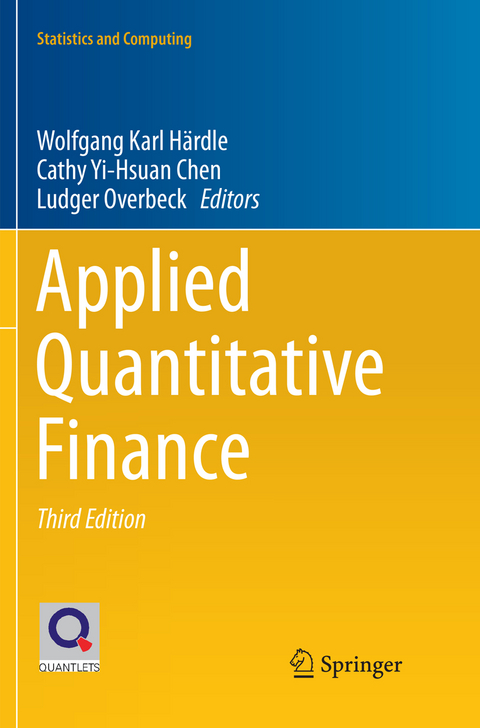
Applied Quantitative Finance
Springer Berlin (Verlag)
978-3-662-57199-6 (ISBN)
This volume provides practical solutions and introduces recent theoretical developments in risk management, pricing of credit derivatives, quantification of volatility and copula modeling. This third edition is devoted to modern risk analysis based on quantitative methods and textual analytics to meet the current challenges in banking and finance. It includes 14 new contributions and presents a comprehensive, state-of-the-art treatment of cutting-edge methods and topics, such as collateralized debt obligations, the high-frequency analysis of market liquidity, and realized volatility.
The book is divided into three parts: Part 1 revisits important market risk issues, while Part 2 introduces novel concepts in credit risk and its management along with updated quantitative methods. The third part discusses the dynamics of risk management and includes risk analysis of energy markets and for cryptocurrencies. Digital assets, such as blockchain-based currencies, have become popular b
ut are theoretically challenging when based on conventional methods. Among others, it introduces a modern text-mining method called dynamic topic modeling in detail and applies it to the message board of Bitcoins.
The unique synthesis of theory and practice supported by computational tools is reflected not only in the selection of topics, but also in the fine balance of scientific contributions on practical implementation and theoretical concepts. This link between theory and practice offers theoreticians insights into considerations of applicability and, vice versa, provides practitioners convenient access to new techniques in quantitative finance. Hence the book will appeal both to researchers, including master and PhD students, and practitioners, such as financial engineers. The results presented in the book are fully reproducible and all quantlets needed for calculations are provided on an accompanying website.
The Quantlet platform quantlet.de, quantlet.com, quantlet.org is an integrated QuantNet environment consisting of different types of statistics-related documents and program codes. Its goal is to promote reproducibility and offer a platform for sharing validated knowledge native to the social web. QuantNet and the corresponding Data-Driven Documents-based visualization allows readers to reproduce the tables, pictures and calculations inside this Springer book.
Wolfgang Karl Hardle is the Ladislaus von Bortkiewicz Professor of Statistics at the Humboldt-Universitat zu Berlin and director of C.A.S.E. (Center for Applied Statistics and Economics), director of the CRC-649 (Collaborative Research Center) "Economic Risk" and director of the IRTG 1792 "High Dimensional Non-stationary Time Series." He teaches quantitative finance and semi-parametric statistics. His research focuses on dynamic factor models, multivariate statistics in finance and computational statistics. He is an elected member of the ISI (International Statistical Institute) and advisor to the Guanghua School of Management, Peking University and a senior fellow of Sim Kee Boon Institute of Financial Economics at the Singapore Management University. Cathy Yi-Hsuan Chen is guest professor at the Humboldt-Universitat zu Berlin School of Business & Economics, a principal investigator in the International Research Training Group 1792 - High Dimensional Non-stationary Time Series and visiting fellow at Sim Kee Boon Institute for Financial Economics, Singapore Management University. Her research interests focus on text mining, finance analysis and risk analysis and management. She has dedicated herself to applying text-mining techniques to distill news flow from social media. She has published in key journals and has written important software for financial econometrics. She applies modern econometric techniques, such as copulae and ultra-high dimensional factor models to financial data on systemic risk indicators. She has professional experience in risk modeling and management in banking industry. Ludger Overbeck is Professor of Mathematics at the University of Giessen, specializing in stochastic processes, as well as mathematical financial and quantitative methods in risk management. His research covers a wide range of topics from infinite-dimensional stochastic analysis, like measure-valued processes, path-dependent stochastic equations and partial differential equations; pricing issues such as term structure modelling for credit products; risk management like portfolio credit risk; and the axiomatic approach to systemic dynamic risk measures. He gained broad professional experience in risk-management quantification issues during his career with the Deutsche Bundesbank, Deutsche Bank, UniCredit and Commerzbank.
Part I Market Risk: VaR in High-Dimensional Systems.- Multivariate Volatility Models.- Portfolio Selection with Spectral Risk Measures.- Implementation of Local Stochastic Volatility Model.- Part II Credit Risk: Estimating DTD via Sequential Monte Carlo.- Risk Measurement with Spectral Capital Allocation.- Market Based Credit Rating and its Applications.- Using Public Information to Predict Corporate Default Risk.- Stress Testing in Credit Portfolio Models.- Penalized Independent Factor.- Term Structure of Loss Cascades in Portfolio Securitisation.- Credit Rating Score Analysis.- Part III Dynamics Risk Measurement: Copulae in High Dimensions - An Introduction.- Measuring and Modeling Risk Using High-Frequency Data.- Measuring Financial Risk in Energy Markets.- Risk Analysis of Cryptocurrency as an Alternative Asset Class.- Time Varying Quantile Lasso.- Dynamic Topic Modelling for Cryptocurrency Community Forums.
| Erscheint lt. Verlag | 12.8.2018 |
|---|---|
| Reihe/Serie | Statistics and Computing |
| Zusatzinfo | X, 372 p. 111 illus., 75 illus. in color. |
| Verlagsort | Berlin |
| Sprache | englisch |
| Maße | 155 x 235 mm |
| Gewicht | 587 g |
| Themenwelt | Mathematik / Informatik ► Mathematik ► Wahrscheinlichkeit / Kombinatorik |
| Wirtschaft ► Allgemeines / Lexika | |
| Wirtschaft ► Betriebswirtschaft / Management ► Finanzierung | |
| Wirtschaft ► Betriebswirtschaft / Management ► Unternehmensführung / Management | |
| Schlagworte | Copula • copula modelling • credit risk • Cryptocurrency • default modeling • dynamics risk measurement • high-frequency data • market risk • Network Risk • Portfolio • Quantitative Finance • Quantitative Methods • Risk Management • systemic risk • time varying quantile lasso • Value at risk • Volatility |
| ISBN-10 | 3-662-57199-4 / 3662571994 |
| ISBN-13 | 978-3-662-57199-6 / 9783662571996 |
| Zustand | Neuware |
| Informationen gemäß Produktsicherheitsverordnung (GPSR) | |
| Haben Sie eine Frage zum Produkt? |
aus dem Bereich


